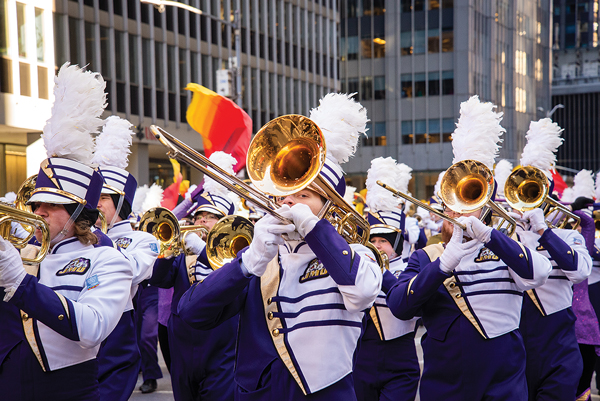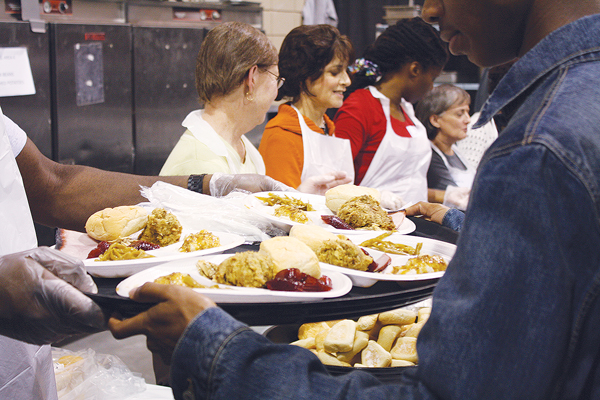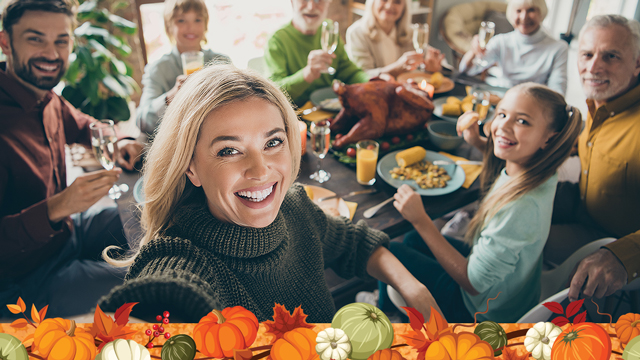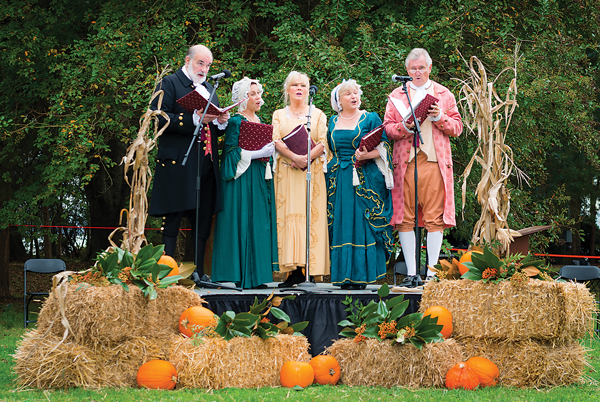Thanksgiving is my favorite holiday. I love watching the Macy’s Thanksgiving Day Parade and sharing a delicious meal with family. And the best part? Unlike many other holidays, there is no pressure to buy gifts for anyone.
Thanksgiving is about food and family. And football. And a time to celebrate with good friends. And the parade. And the start of the Christmas season. And Black Friday shopping. And volunteering. Okay, although at its core, Thanksgiving is about food and loved ones, over the years, the holiday has become a bit of a smorgasbord.
Football
For Midlothian resident Mike Adams, Thanksgiving is about food and family and football. “On Thanksgiving, I have the same feeling I have had since I was a kid,” says Adams. For him, Thanksgiving is a fun day off work to watch games while spending time with family and eating good food. And, like many families around the country, when the games aren’t on, Adams and his crew head outside to play some football of their own.
It turns out, football became integrated with Thanksgiving not long after the holiday became national. The first Thanksgiving football game was played in Philadelphia in 1869, just two weeks after Princeton and Rutgers played what is considered to be the first-ever football game.
From 1876 to 1881, Yale and Princeton played on Thanksgiving Day, and the Boston Latin School and English High School of Boston have played on Thanksgiving every year since 1887. According to historians who study this type of thing, thousands of Thanksgiving football games were being played by the 1890s.
The NFL got into the action when it was founded in 1920, scheduling as many as six games on Thanksgiving Day. The tradition of the Detroit Lions and Dallas Cowboys playing each year on Thanksgiving developed a little later, though.
In 1934, the owner of the Lions, George A. Richards, was trying to help boost the franchise, so he grabbed onto Thanksgiving’s coattails and added something new. As the owner of a radio station affiliated with NBC Radio, he negotiated with the network to carry the game live. So began the Thanksgiving tradition of following a football game from the comforts of one’s own home. After World
War II ended, however, the Lions were the only team left playing an annual home game on Thanksgiving Day.
In 1966, the Cowboys began hosting Thanksgiving games, and in 1978, they negotiated a deal stating they would play each Thanksgiving. Since then, the Lions have played a morning game, and the Cowboys have played in the afternoon. In 2006, the NFL added a third game in the evening, which absolutely thrilled Adams. Because there’s never enough football, right?
Friends
My favorite Thanksgiving football game is the one played by Monica, Ross, Chandler, Joey, Rachel, and Phoebe on Friends. In that 1996 episode, Monica and Ross compete ruthlessly, reliving an angst-ridden family tradition. Friends not only played into this tradition of Thanksgiving and football, the show also helped popularize the concept of Friendsgiving, a gathering of friends rather than family to celebrate Thanksgiving Day.
For Henrico resident Aditi Singh, whose family lives far away, Thanksgiving is the perfect opportunity to host a meal and celebrate gratitude with several families who have become good friends. “I grew up seeing Thanksgiving on American TV,” says Singh, who thought it looked like a fun holiday. She moved to the States from Kuwait in 2007 and started celebrating Thanksgiving five years later. The number of families attending Singh’s celebration differs each year, but there have been as many as ten.
A self-described foodie, Singh incorporates traditional Indian foods into the meal, serving tandoori chicken and using spices from the cuisine she grew up eating. “I applied Indian tadka to Thanksgiving,” Singh says, using the word that means adding more flavoring to food.
Although Singh invites family friends to celebrate the day of gratitude with her each Thanksgiving, she doesn’t refer to it officially as Friendsgiving. The weekend before Thanksgiving, though, her friend hosts an Indian potluck party, which they refer to as Friendsgiving.
Midlothian resident Meg Cogswell also enjoys Friendsgiving the Saturday before Thanksgiving. Her decision to host between sixty and seventy people for a Thanksgiving feast was inspired not by Friends, but by A Charlie Brown Thanksgiving. That holiday special, first airing in 1973, details the quandary Charlie faces when his friends start arriving to celebrate Thanksgiving at his house and end up celebrating with his grandmother. Cogswell says, “When I watched the Peanuts special, I thought, Why can’t we do this?”
Cogswell has been hosting a feast for this large group of college friends for eleven years. To feed such a large crowd, Cogswell cooks three or four turkeys. “We have a 3-page grocery list that includes three boxes of butter,” she says. In the midst of preparations, Cogswell wonders if the effort is worth it, but she always decides it is. Her Friendsgiving has become a tradition her whole family loves.

Parade
While growing up in New York, Cogswell would sometimes attend the Macy’s Thanksgiving Day Parade or watch the huge balloons being blown up the night before. In recent years, she has taken her kids to see it when visiting family for the holiday, but she says the event has grown into a much bigger production since her childhood.
“There are people everywhere – as many people as you can possibly imagine,” says Cogswell.
When the parade first took place in 1924 (it was called the Macy’s Christmas Parade then), 250,000 people attended, and the route stretched for six miles. Now, more than 3.5 million people flock to the New York streets over the 2.5-mile route, and over 50 million people watch from home.
That first parade was planned to showcase the Macy’s expansion – it touted itself as the world’s largest store – and kick off the Christmas shopping season. Scheduled between church services and the Syracuse/Columbia football game, the circus-like parade, complete with elephants, began to assert its primacy amidst Thanksgiving traditions.
Over time, however, the parade has changed. The potentially uncooperative animals from the Central Park Zoo were replaced by balloons; the first, Felix the Cat, appeared in 1927. Originally those balloons floated away after the parade, and the person who found them received a gift. That practice ended in 1932, when one of the balloons got wrapped around an airplane’s wing, causing a mid-air collision. From 1942 to 1944, the Macy’s Parade was put on hold, and 650 pounds of balloon rubber were donated to the war effort. The parade resumed in 1945 and was first broadcast on national TV three years later.
JMU student Adam Miller, who grew up in Short Pump, had the chance to experience the parade firsthand last year as a sousaphone player when JMU’s Royal Marching Dukes were invited to perform. “We were super-psyched when we found out in 2017,” says Miller, “and we prepared for months.”
Nothing could have prepared them, though, for the intensity of the experience. In the middle of the night, Miller and the rest of the band performed in the dress rehearsal that took place on the parade route. After a quick trip back to their hotel for breakfast, they had to be back to Central Park by six thirty in the morning, enduring frigid temperatures.
The 2018 Parade was the coldest one on record, and Miller and his bandmates felt it. “Our instruments were freezing, our valves were freezing, our mouthpieces had icicles hanging down,” he says. “It was painful, but worth it.”
Being part of such an amazing experience – including seeing John Legend and Pentatonix up close as they waited to perform – made it a once-in-a-lifetime experience he will always remember. “More than half the band members would say they would never do it again,” Miller says. “I would do it every year if I could.”
Christmas Kick-off
When Santa arrives at the end of the Macy’s Thanksgiving Day Parade, he ushers in the Christmas season. While some prefer to separate Thanksgiving and Christmas, others, like Goochland resident Martha Stwodah, embrace Thanksgiving as the first day of the Christmas season.
On Thanksgiving morning, Stwodah is awake by six o’clock to cook the turkey for their Thanksgiving feast. She prepares much of the food the day before, including her famous cornbread biscuit dressing, so she has plenty of time on Thanksgiving to decorate for Christmas while also watching favorite Christmas movies in between football games.
Each year, Stwodah, who says she is “huge into Christmas,” puts up at least three themed Christmas trees, one of which is delivered and set up the next morning by the Tree Elves, who come dressed as elves and bearing King of Pops, the yummy local frozen treat. “It’s a fun and festive tradition,” Stwodah says.
For Stwodah, decorating for Christmas on Thanksgiving Day enables her to enjoy a full month of the season she loves. By then, she has finished her Christmas shopping, so with the decorating finished, she can avoid the stress so many experience during the season. “I can focus that time of year on family, charity and outreach events, friends, and festivities,” Stwodah says.

Service
Because Thanksgiving is a time for gratitude, many families choose to spend the day – or at least a portion of it – giving back to the community. That can involve running a turkey trot to raise money for a charity or volunteering to feed the homeless.
Each year, North Chesterfield resident Tina Gee spends Thanksgiving helping those in need through The Giving Heart’s Community Thanksgiving Feast at the Greater Richmond Convention Center. Founded in 2003 by Vicki Neilson, The Giving Heart began hosting the first feast two years later. It takes over 800 volunteers to organize, prepare, and serve the meal to nearly 3,000 guests.
Gee first learned about The Giving Heart’s event after she saw a sign for it while buying turkeys to give away through her church, Mountain Movers Ministry. “I contacted Vicki and became the transportation coordinator,” she says.
Gee says she volunteers for the Community Thanksgiving Feast to show her grandchildren how they can give back. When she and her husband volunteer, they have a chance to talk to and listen to the people they serve. That experience helps fulfill the mission of their church. “Our church believes church is not within the four walls of a building,” says Gee. “It’s in our community.”
Shopping
Macy’s was onto something when they focused on Thanksgiving as a time to kick off Christmas shopping. This past year, it was estimated that over 100 million of us sought out bargains online or in stores during Black Friday.
Historians date the origin of the term Black Friday to the 1950s, when Philadelphia police officers used it to describe the chaos of people shopping on the day after Thanksgiving. In the late 1980s, stores reinvented the term, connecting it instead with the idea that businesses could go from “red” for loss to “black” for profit during the busy holiday shopping season. In the past ten years, Black Friday has expanded to include early morning hours on Friday and more recently, to the evening of Thanksgiving.
Over the years, the major shopping event has become tradition for Midlothian resident Laith Shevalier, who was first invited to go with a friend. She loved it, and now goes every year. Although Shevalier celebrates finding a bargain, she takes a more relaxed approach than some shoppers. “Whatever happens,” she says. “I always get a deal.”
Each year, Shevalier makes the most of Thanksgiving, enjoying a meal with family and then shopping in the evening after having helped with feast cleanup. She typically gets back home five or six hours later, but she says the time flies. “It’s an adrenaline rush to get really great deals,” Shevalier says. Now that her 14-year-old accompanies her, it has also become perfect mother-daughter bonding time.
Whether we spend Thanksgiving watching football or the Macy’s Parade, volunteering to serve, or bonding over bargains, the holiday is a perfect time to gather with family, friends, and community while remembering to be grateful for our many blessings.
Photo: Matt Cosner (JMU Marching Band)
Thanksgiving Food Factoids
Had Sarah Josepha Hale not promoted the Plymouth Harvest Feast as the First Thanksgiving, would we be eating oysters and ham like the settlers at Berkeley? Or maybe pork and beans as the Spanish settlers did? (Turn the page to read all about Thanksgiving history!) As is, culinary historians have argued that our traditional Thanksgiving foods have little to do with what was actually eaten centuries ago.
No Turkey
Close to 90 percent of Americans eat turkey each year at Thanksgiving, but turkey probably wasn’t served at the first Thanksgiving (wherever you believe it took place). For their feast, the settlers and Indians likely ate wild fowl, venison, and seafood. Although writings from Plymouth Plantation Governor William Bradford describe wild turkeys roaming around, culinary historians believe they would have eaten duck or goose, or even swan or passenger pigeons.
Turkeys for Thanksgiving came into the picture later, probably because they were cheaper and could feed more people than other types of poultry. The idea of serving turkeys – like the idea of Thanksgiving itself – can also be traced to Hale, who romanticized the bird in her 1827 novel Northwood: “The roasted turkey took precedence on this occasion, being placed at the head of the table; and well did it become its lordly station, sending forth the rich odor of its savory stuffing, and finely covered with the froth of its basting.”
No Pumpkin Pie
Pumpkins were likely on the harvest feast menu served the way Native Americans ate them: baked and moistened with animal fat, maple syrup, and honey. Filling a crust with meat, vegetables, or fruit was a familiar concept to the English, but, in the New World, they didn’t have access to butter or flour to make a pie. Pumpkin pie became a staple later when Amelia Simmons published a recipe in her 1796 cookbook.
No Mashed Potatoes
Culinary historians don’t think potatoes would have been on the menu either. Although they were introduced at some point during the 1600s, potatoes didn’t become widely available until 1719 when introduced in New Hampshire by Scotch-Irish immigrants. Instead of potatoes, the settlers and Native Americans at Plymouth probably ate wild rice as their starch.
No Sweet Potatoes (or Yams!)
Though they may have been popular in the South at that time, sweet potatoes probably weren’t served in Plymouth. They likely became popular at Thanksgiving when Hale wrote about sweet potato pie. The controversial recipe for sweet potatoes topped with marshmallows first appeared in a booklet published in 1917 by Angelus Marshmallows. For better or worse, the idea stuck.
No Stuffing – As We Know It
The settlers at Plymouth might have used chestnuts and herbs to flavor their turkey, but they didn’t have the flour and butter to make stuffing as we know it. And though I call it stuffing, it seems many people, particularly Southerners, refer to it as dressing. Regardless of what we call them or why we even eat them, these traditional Thanksgiving foods mark the memories of past celebrations. In what has become known as a “Proustian moment,” French author Marcel Proust wrote how a taste of a madeleine cookie flooded him with memories of his childhood. In the same way, the taste of my grandmother’s butter beans immediately brings me back to the many years we celebrated Thanksgiving with my mother’s side of the family. And whenever my family celebrates Thanksgiving with my in-laws, my daughters insist that we serve my mom’s stuffing recipe – a deliciously doctored-up version of Stove Top – because Thanksgiving somehow isn’t Thanksgiving without it!
Will the Real First Thanksgiving Please Stand?
After the British surrendered at Saratoga, the Continental Congress first declared a day of thanksgiving to be held December 18, 1777. Two years later, George Washington declared November 26, a day of thanksgiving to honor the creation of the U.S. Constitution. Other early presidents declared days of thanksgiving, but there wasn’t a national holiday until many years later.
Thanksgiving might not have become a national holiday in the modern era if not for much persuasion and effort by Sarah Josepha Hale, author of “Mary Had a Little Lamb” and editor of a women’s magazine, Godey’s Lady’s Book. Over the course of thirty years, Hale wrote newspaper editorials and letters to the government and lobbied many different presidents, without success, asking for a federal holiday called Thanksgiving.
Then the Civil War happened. When Hale reached out to Abraham Lincoln to bring back a national Thanksgiving celebration to foster unity, the idea resonated with him. On October 3, 1863, Lincoln declared a national day of Thanksgiving to be celebrated on November 26.
From then until 1939, Thanksgiving took place the last Thursday of the month. That year, though, the last Thursday was the last day of November, and businesses were concerned there wouldn’t be enough holiday shopping days. Then-president Franklin D. Roosevelt moved Thanksgiving to the second to last Thursday to provide more time for shopping. Sixteen states refused to go along, so for two years, Thanksgiving was celebrated at two different times. In 1941, Congress voted for Thanksgiving to fall on the fourth Thursday of the month.
Many of us learned in school that Thanksgiving is centered around the Plymouth harvest feast that took place in 1621 between about fifty settlers and ninety men from the Wampanoag tribe of indigenous people. Boston clergyman Alexander Young celebrated the feast of Plymouth as the first Thanksgiving in Chronicles of the Pilgrim Fathers, published in 1841, and Hale promoted that connection. Before long, that momentous event had asserted its role in the cultural consciousness.
Many historians have debated, however, whether that event can be considered the genuine first Thanksgiving. For one thing, many argue, it was a harvest feast, not an event of giving thanks.
On December 4, 1619, two years before the feast at Plymouth, English settlers landed their ship Margaret thirty miles from Jamestown at Berkeley in Charles City County. The ship’s charter required that they set aside the day of landing as a day of thanksgiving. So, when their tumultuous journey ended, Captain Woodlief commanded his crew of thirty-five men to kneel on the grass and pray, proclaiming, “We ordain that the day of our ship’s arrival, at the place assigned for plantation, in the land of Virginia shall be yearly and perpetually kept holy as a day of thanksgiving to Almighty God.”
In 1962, Virginia Senator John J. Wicker brought the Berkeley account to then-President John F. Kennedy’s attention when he sent a telegram regarding a speech in which Kennedy credited only the pilgrims in Massachusetts as having celebrated Thanksgiving. The next year, the president included a mention of settlers in Virginia.
Each November, Berkeley Plantation celebrates the Virginia Thanksgiving Festival with a reenactment of the first landing. “We act out landing the ship, making observations, giving an official role call, reading the proclamation, and saying a prayer,” explains Lucas Hall, an actor from Richmond who participates in the Festival. “This Thanksgiving is a day of prayer.”
This year’s celebration commemorates the 400th anniversary with the reenactment as the culmination of a festival that starts with a parade and includes performances by the Chickahominy Tribal Dancers and The Itinerant Band and Colonial Singers of Williamsburg.
While some debate that the landing at Berkeley should be considered the first official Thanksgiving, others suggest the holiday should be based on earlier settlers who celebrated their arrival with a meal. In its writings on the subject, the National Park Service suggests the first Thanksgiving took place in 1565 in Florida between the Spanish settlers and the Seloy tribe, who enjoyed a meal of salted pork and garbanzo beans. Others point to Texas in 1598, when the Spanish explorer Juan de Onate held a Thanksgiving festival along the banks of the Rio Grande to celebrate their 50-day march across the desert.
Photo: Gary Smith






